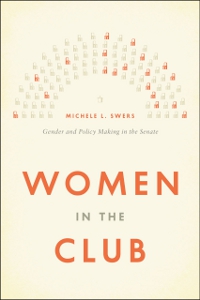The current 113th Congress has the most women Senators in the body’s 225 year history: 20. Michele L. Swers’ book, Women in the Club: Gender and Policy Making in the Senate, is an in-depth look at the influence of gender on policymaking in government, which combines quantitative analyses of legislative behaviour with qualitative interviews with senate staffers and Senators themselves. Elizabeth Evans finds the book to be a fascinating read, one that will be useful to scholars of policymaking and gendered institutionalism alike.
 Women in the Club: Gender and Policy Making in the Senate. Michele L. Swers. University of Chicago Press. May 2013.
Women in the Club: Gender and Policy Making in the Senate. Michele L. Swers. University of Chicago Press. May 2013.
It’s been over twenty years since 1992 was hailed as the Year of the Woman, so-called because of an increase in the number of female senators elected to the US Congress. Progress with regards to women’s numerical political representation, whilst not having ground to a halt, has been slow. Although it’s no longer a case of Nine and Counting, currently there are just twenty women in the 100 strong chamber; put another way, 80 percent of senators are men. Of the twenty female senators, which represent the largest number elected to date, 16 are Democrat and 4 are Republican. This inter party difference is not unimportant and indeed as we might expect it shapes and influences the differing perceptions of women’s issues amongst the women senators. With so few women members it’s hard to make generalisations regarding the style and behaviour of the women ‘in the club’, which is why Michele Swers’ painstaking analysis of the influence of gender on policymaking and the informal relationships and codes governing the Senate, makes for such an important and interesting book.
Swers, an Associate Professor of American Government at Georgetown University, explores whether or not women senators are more pro-active with regards women’s issues and the extent to which gendered assumptions and expectations dictate the kinds of policy agendas that senators pursue once elected. Adopting a multi method approach, Swers analyses the often complex relationship between gender, party, seniority and electoral priorities that affect legislators’ behaviour. Her research draws upon quantitative analysis of bill sponsorship and co-sponsorship, voting records and amendments, a standard methodological approach for this type of legislative research. More interestingly, Swers supplements this data with interviews undertaken with Senate staffers and a few senators. The rich and illustrative data gleaned from these qualitative interviews adds an original and important depth to the book. In particular, the insights of staffers provide the reader with a greater understanding of the policy decisions and strategies adopted by senators including: partisan territoriality, “women’s issues are not Republican issues” (p.51); collaborative partnerships between female senators, “they work together on preschool education and after-school programs, child-related issues” (p.65); and the significant constituent pressure placed on senators when it comes to votes on reproductive rights, “[Blanche] Lincoln is religious, but she is also a believer in women’s rights […] she voted for the partial birth abortion ban because of the barrage of constituent input” (p.113).
The book’s central claim, “that gender is a fundamental identity that affects the way senators look at policy questions, the issues they prioritize, and the perspective they bring to develop solutions” (p.3) is well supported by the quantitative data and successfully underscored by the qualitative research. The inter-party difference between Democrat and Republican women is also a key contention of the book, with Democrat women acting “as ambassadors to women voters, promoting how the party’s policies help women.” (p.16), whilst Republican senators frequently have to make personal compromises based on the often congruent demands of their constituents and party leadership.

The ways in which policy choices that women senators make is best illustrated through the fascinating analysis of the ongoing and high profile abortion debates. Chapter three provides a close reading of the various factors that shaped the responses of female senators to the Partial Birth Abortion Act 2003: including, constituent and party views, public opinion and the roles of the anti-choice and pro-choice lobbies. Swers observes that for Republican women, abortion is an issue that they don’t want to be associated with:
“Pro-choice Republican women seek to maintain voting records supporting reproductive rights, while avoiding alienating their pro-life colleagues. Pro-life republican women vote their preferences, while resisting efforts to elevate their role by becoming party spokespersons.” (p.121)
Indeed, Swers observes that Republican men were the main proponents of the ban whilst four of the five Republican women supported positions that ran counter to the majority opinion of their party caucus.
The book covers a wide range of issues from equal pay, to national security and judicial nominations; and the breadth of the research does not come at the expense of depth. At times, the reader may find the amount of data presented somewhat overwhelming, particularly those that feature on pages 79-84 (this might have been more usefully included in an appendix), but it is useful to see the full regression tables nonetheless. The book might also have benefited from a clearer introduction to the Senate, especially for those readers not well versed in its workings. That said, for students and scholars of policy making, institutionalism and gendered institutionalism this book will make for a fascinating read. Although it confirms much of what we might have suspected vis-à-vis the competing tensions that Republican women politicians have to address, the thorough empirical analysis presented in this book allows us to more confidently think through the gendered claims frequently made by parties and politicians.
—————————————
Dr Elizabeth Evans is Lecturer in Politics at the University of Bristol. Her book, Gender and the Liberal Democrats: Representing Women?, was published by Manchester University Press in 2011, and she has published articles in Parliamentary Affairs, British Politics, Representation, The British Journal of Politics and International Relations and The Political Quarterly. She is currently working on a comparative analysis of UK and US third wave feminism due to be published with Palgrave. Read more reviews by Elizabeth.






